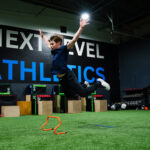Speed and Agility Training Enhances Team Communication
Team sports thrive on communication and coordination. Without clear, quick interaction, even the fastest players can struggle to succeed.
What if I told you that speed and agility training — beyond physical benefits — also plays a vital role in building better team communication?
Yes, training quick feet can also train quick minds and better on-field conversations. When athletes train speed and agility together, they develop instincts for reading teammates, calling plays, and moving as one unit.
In this article, you’ll learn how speed and agility drills strengthen team communication, why this matters, and practical drills to try with your squad.
Why Team Communication Is Critical in Sports
No matter the sport, teammates must constantly:
-
Share information quickly
-
Anticipate each other’s moves
-
Adjust strategies on the fly
-
Support and motivate each other
Poor communication creates gaps, misreads, and missed opportunities. Strong communication increases fluidity and sharpens team defense and attack.
The Connection Between Physical Speed and Communication Speed
We often think of communication as purely verbal or cognitive. But it also involves physical cues:
-
Body language
-
Eye contact
-
Timing of movement
Speed and agility drills hone an athlete’s ability to:
-
React instantly to teammates
-
Move synchronously
-
Read nonverbal signals
This builds a shared language on the field that words alone can’t create.
How Speed and Agility Training Builds Communication Skills
1. Improves Spatial Awareness and Positioning
Agility drills require athletes to:
-
Navigate space efficiently
-
Maintain proper distance from teammates
-
Move into passing lanes or defensive zones
This increases situational awareness, a cornerstone of effective communication.
2. Enhances Nonverbal Communication
Fast-paced drills make verbal commands impractical. Instead, athletes learn to:
-
Signal with hand gestures
-
Use eye contact
-
Adjust positioning instantly based on teammates’ cues
Speed and agility training builds this nonverbal dialogue naturally.
3. Builds Trust Through Shared Effort
When teammates push through challenging agility drills together, they:
-
Encourage each other
-
Develop shared goals
-
Experience collective success and failure
This strengthens interpersonal bonds, making communication more natural during games.
4. Trains Decision-Making Under Pressure
Agility exercises often include rapid choices — which direction to cut, whom to pass to, when to switch defense.
These split-second decisions sharpen:
-
Cognitive communication
-
Anticipation of teammates’ actions
-
Synchronization in play execution
Practical Speed and Agility Drills to Boost Team Communication
Drill 1: Agility Relay With Communication
Setup: Divide players into small teams. Set up cones in a zig-zag pattern.
How to Run: Each athlete sprints and weaves through cones, then tags a teammate who continues.
Communication Element: Athletes call out the next runner’s name before tagging and give quick verbal feedback.
Benefit: Promotes quick verbal cues and boosts trust in timing.
Drill 2: Partner Mirror Drill With Callouts
Setup: Pair players face-to-face, about 5 feet apart.
How to Run: One player leads lateral or forward/backward agility movements; the other mirrors.
Communication Element: Leader calls out movements and changes tempo verbally; partner responds.
Benefit: Develops synchronized movement and verbal/nonverbal feedback loops.
Drill 3: Agility with Signal Passing
Setup: Create a square with cones; position 3-4 players around.
How to Run: Players run agility patterns, then make passes after a teammate signals (with a hand or shout).
Communication Element: Requires players to read signals and adjust timing.
Benefit: Enhances timing, focus, and coordination under movement.
Case Study: Basketball Team’s Communication Breakthrough
At Next Level Athletics, a high school basketball team struggled with miscommunication on fast breaks and defensive rotations.
After integrating speed and agility drills emphasizing communication:
-
Players improved verbal and nonverbal cues
-
Turnovers decreased by 15%
-
Team chemistry visibly improved during games
Coach’s feedback: “They’re now talking with their feet and eyes before their voices.”
Scientific Support for Training Communication Through Movement
Research published by the National Strength and Conditioning Association (NSCA) highlights that team dynamics improve with drills incorporating cognitive and physical components.
Teams practicing coordinated movement drills report better on-field decision-making and enhanced social bonding.
Tips for Coaches to Maximize Communication Gains
-
Make drills competitive but supportive: Use timed relays with encouragement.
-
Encourage consistent feedback: Teach players to give quick, constructive comments.
-
Use video review: Show how communication improved movement and outcomes.
-
Mix up drills: Keep players mentally engaged with new challenges.
-
Promote off-field communication: Team meetings or huddles strengthen trust.
Final Thoughts: Speed, Agility, and Communication Win Games
Physical training often focuses on individual skills, but the best teams move and think as one.
Speed and agility training isn’t just about faster feet. It’s about sharper minds, better teamwork, and stronger communication.
When teams integrate communication into their agility drills, they build unspoken bonds that last beyond practice — leading to smarter plays, fewer errors, and more wins.
To unlock your team’s full potential, combine speed, agility, and communication in every drill and watch your team’s connection thrive.


Recent Comments